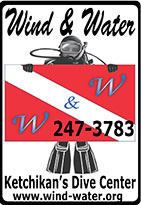|
Fish Factor Jobs Await for Next Generation of Fishery & Ocean SpecialistsBy LAINE WELCH
November 20, 2016
Since 1987, the College of Fisheries and Ocean Science (CFOS) at the University of Alaska Fairbanks has offered undergraduate and graduate degrees in Fisheries Science, complete with paid internships to help prepare them for positions in the state’s largest industry.
“It’s a degree path preparing students for what I call fish squeezers – they’re going to go to work for the Alaska Dept. of Fish and Game, or NOAA, the U.S. Fish and Wildlife Service or some other type of agency where they’re going to be primarily out doing field work, traditional fish biologist types,” said Trent Sutton, a Professor of Fisheries Biology and Associate Dean of Academics. Due to student interest, the college broadened the fisheries degree this fall to include ocean sciences, and opened more oceanography and marine biology classes to undergraduate students. The new degree combo program attracted 53 students, Sutton said. The college also is a center for ocean acidification studies, which is a big student draw. “You hear all the concerns regarding climate change and marine mammals and fisheries and sea ice – all of those garner interest from students because there are job opportunities down the road to deal with these issues,” Sutton explained. The CFOS also is the only school in the nation to offer a bachelor of arts degree in fisheries for students interested in seafood sciences and technology, and marine policy. Another focus of the B.A. track is in rural and community development where students can get the degree at home. “A student in Bethel or Dillingham can stay home and take 100 percent of their courses either through video conferences or online or by some other distance delivery technology. They can get a degree that is tied to fisheries and it will help them have a good career and become leaders in their communities,” Sutton said. Starting next fall, CFOS plans to offer the degree programs in partnership with the University at Southeast Alaska (UAS), and eventually to the Anchorage campus and other regions. A shorter career track for fisheries technologists also is offered through UAS/Sitka to train students for jobs as fishery observers, surveyors, culturists and hatchery technicians. Fish tech certification and associates degree courses are offered remotely, with classes fully loaded onto iPads and no internet is required. There is a dire shortage of fish techs in Alaska and that trend is expected to continue for at least a decade, according to university data. In fact, good careers await fisheries and ocean science grads in Alaska, as state agencies are steadily losing workers to retirement – 20 percent from ADF&G alone over the next few years, and a similar amount from federal fisheries agencies. Of the nearly 700 graduates the College of Fisheries and Ocean Sciences has produced over 30 years, nearly half have gone on to careers at ADF&G and NOAA Fisheries, Sutton said. “These students are not only staying in the state,” he said, “but they are working for the agencies that are making the management and policy decisions that impact our fisheries and marine resources.” Bait bites Baits are critical to most fishermen’s catches and it can be a scramble to find ample supplies that change with the times. “Things change over the years. We always try to find what is the new best thing and try and stay ahead of the curve,” said Justin Hackley, vice president of sales and marketing for International Marine Industries of Newport, Rhode Island, a global bait provider for over 30 years. Alaska is one of Hackley’s biggest customers and bait favorites have shifted due to changing weather patterns and cyclical availabilities of the fish. For decades it was east coast herring that kept Alaska fleets out fishing – until a better fish surfaced. “It was herring for halibut or black cod longlining, or for crab or pot cod until a cheaper alternative came around – Pacific sardines caught off the coast of Astoria. That fish had fat content at 18 percent, way higher than you can get out of east coast herring,” Hackley said. But the Pacific sardine fishery closed three years ago, and Hackley scrambled to find another bait replacement. It took some convincing, but last year Kodiak fishermen and processors agreed to bite. “Pacific saury is the new up and coming bait that last year we got them to take, and it’s been quite successful,” he said. Saury will be soaking in Tyler O’Brien’s pots when he sets out on the 58-foot Odin’s Eye for cod in January. At $1.00 a pound (up from 50 cents last year), he estimates the bait cost will be $4,500 for each three-day fishing trip. Fishermen use different baits depending on the fishery, and often mix up their own blends from scraps to save money, O’Brien said. “For crab we’ll catch and use fresh herring or cod and salmon roe. In the fall, we’ll get pink salmon discards from processors for halibut bait. We try and follow the seasonal tastes of the fish,” he explained. Pacific saury already is feeling pressure from increasing demand, Hackley said, and bait prices for short supplies of squid have increased to $1.35 a pound at Dutch Harbor, up from 85-90 cents a year ago. A newer bait alternative gaining traction in Alaska is pollock. “I used to sell a lot of longline herring to halibut guys and everyone seems to want pollock now,” he said. So why aren’t Alaska fisheries using local species as bait? In the case of herring (65 cents a pound) for halibut, at least, Hackley said size matters. “These longliners want a certain size. Typically, herring from Sitka is too small and the Dutch Harbor herring is too big. But it is good for the pot guys,” he said. Hackley credits Alaska for its sustainable management practices and believes he’ll have a good customer long into the future. “As long as people are out there fishing and pots and hooks are going in the water,” Hackley said, “I’ll be there throwing frozen bait at ‘em.” Fish watch The total salmon harvest for the 2016 season came in at 112 million fish, based on preliminary numbers from the Alaska Dept. of Fish and Game. The value to fishermen of $406 million is the lowest since 2002. The 2017 catch of sockeye salmon at Bristol Bay is pegged at 27.5 million; that compares to a harvest of 37.3 million reds this year. State managers predict Upper Cook Inlet fishermen will see a much lower commercial harvest of just 1.7 million sockeye salmon next summer, one million fish below the 20-year average. The forecast for pink salmon in Southeast Alaska is for a “strong” catch in the 43 million range; that compares to just 18 million pinks taken in the region this summer. The halibut industry will soon get a glimpse of next year’s potential catches when the International Pacific Halibut Commission meets Nov. 29-30 in Seattle. The IPHC also will take up 13 requests for management changes to the fishery, including whether it will be legal to catch halibut with pots in 2017. The fishery will reopen in March. The state Board of Fisheries meets in Homer November 30-December 3. The focus is on commercial, sport, subsistence and personal use fisheries in Lower Cook Inlet.
Laine Welch ©2016 Laine can be reached
at msfish[AT]alaska.com
Representations of fact and opinions in comments posted below are solely those of the individual posters and do not represent the opinions of Sitnews.
SitNews ©2016 Stories In The News Ketchikan, Alaska
|
||||






